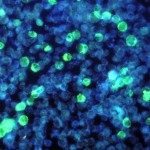Link to Pubmed [PMID] – 19726518
J. Virol. 2009 Nov;83(22):11795-807
To evaluate the impact of immunodominance on CD8 T-cell properties, we compared the functional properties of dominant and subdominant populations in the response to lymphocytic choriomeningitis virus (LCMV). To improve functional discrimination, in addition to the usual tests of phenotype and function, we used a sensitive technique that allows the screening of all CD8 effector genes simultaneously in single cells. Surprisingly, these methods failed to reveal a major impact of clonal dominance in CD8 properties throughout the response. Aiming to increase clonal dominance, we examined high-frequency transferred P14 T-cell receptor transgenic (TCR Tg) cells. Under these conditions LCMV is cleared faster, and accordingly we found an accelerated response. However, when Tg and endogenous cells were studied in the same mice, where they should be subjected to the same antigen load, they showed overlapping properties, and the presence of P14 cells did not modify endogenous responses to other LCMV epitopes or a perturbed immunodominance hierarchy in the memory phase. Using allotype-labeled Tg cells, we found that during acute infection up to 80% downregulated their TCR and were undetectable by tetramer binding, and that tetramer-negative and tetramer-positive cells had very different features. Since Tg cells are not available to evaluate immune responses in humans and, in many cases, are not available from the mouse, the tetramer-based evaluation of early immune responses in most situations of high viremia may be incomplete and biased.

